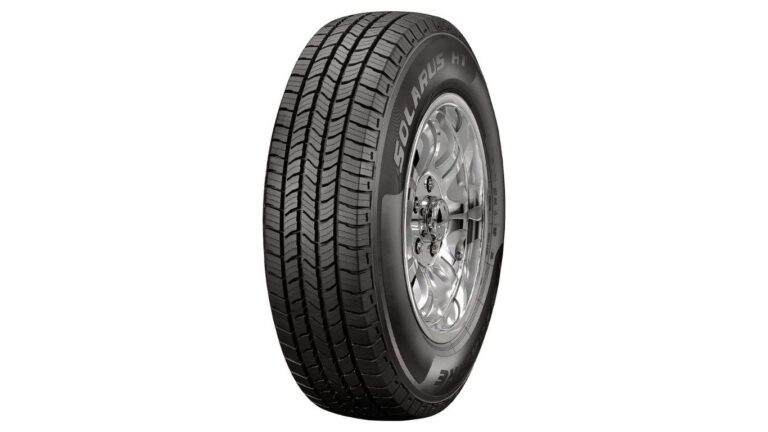Decoding Tire Speed Ratings
Get ready to hit the road with confidence as we unravel the secrets of tire speed ratings.
Just like a well-orchestrated symphony, the speed rating on your tires plays a crucial role in the overall performance of your vehicle.
In this informative article, we will decode the significance of tire speed ratings, dispel common misconceptions, and guide you in choosing the perfect rating for your vehicle.
Stay tuned as we unveil the key factors to consider and ensure your safety on the open road.
Key Takeaways
- Tire speed ratings indicate the maximum speed a tire can safely handle.
- Adhering to the recommended speed limits indicated by the tire manufacturer is crucial for safety.
- Regular tire maintenance is essential for optimal performance and longevity.
- Adhering to recommended tire speed ratings guarantees optimal vehicle performance and safety.
Understanding Tire Speed Ratings
In order to fully grasp the implications of tire speed ratings, it is essential to understand how these ratings relate to a tire's overall performance. Tire speed ratings are standardized codes that indicate the maximum speed a tire can safely handle. These ratings are assigned by the tire manufacturer and are based on extensive testing and research.
Tire speed ratings play a crucial role in ensuring the safety and performance of a vehicle. When a tire is operated at speeds higher than its designated rating, it can result in excessive heat buildup, leading to tire failure. Therefore, it is important to adhere to the recommended speed limits indicated by the tire manufacturer.
Maintaining proper tire speed ratings involves several factors. Firstly, it is crucial to ensure the accuracy of the vehicle's tire speedometer calibration. This can be done by consulting the vehicle's owner's manual or seeking assistance from a professional mechanic. Secondly, regular tire maintenance is essential to ensure optimal performance and longevity. This includes regular inspections, proper inflation, and rotation of tires to ensure even wear.
Importance of Tire Speed Ratings
Adhering to the recommended tire speed ratings is imperative to guaranteeing optimal vehicle performance and safety on the road. Tire speed ratings indicate the maximum speed at which a tire can safely operate based on its construction and design. These ratings are typically represented by a letter code, such as 'V' or 'H,' which corresponds to a specific maximum speed in miles per hour. Understanding and comparing tire speed ratings is essential when choosing the right tires for your vehicle.
When comparing tire speed ratings, it is important to note that higher speed ratings offer several benefits. Tires with higher speed ratings are designed to handle higher speeds, which means they have enhanced stability and control. This can be particularly advantageous for drivers who frequently travel at high speeds or on highways. Additionally, tires with higher speed ratings often have better grip and handling capabilities, providing improved performance in both wet and dry conditions.
However, it is crucial to remember that selecting tires with speed ratings that exceed your vehicle's capabilities is unnecessary and potentially dangerous. It is recommended to match the speed rating of your tires to the maximum speed capabilities of your vehicle. By doing so, you can ensure optimal performance, handling, and safety on the road. Always consult with a tire specialist or refer to your vehicle's owner's manual to determine the appropriate tire speed ratings for your specific needs.
How Are Tire Speed Ratings Determined
Tire speed ratings are determined through rigorous testing and calculation processes.
The speed rating of a tire is determined by its ability to withstand and maintain a certain speed without compromising safety or performance.
Factors such as tire construction, tread design, and the materials used in manufacturing all play a role in determining the appropriate speed rating for a tire.
Speed Rating Calculation
Determining the appropriate speed rating for a tire involves considering various factors such as the tire's performance capabilities and safety requirements. Speed rating guidelines are used to ensure that tires are designed to handle specific speeds without compromising safety. Here are three key factors to consider when calculating the speed rating for a tire:
- Performance Capabilities: Tires with higher speed ratings are designed to provide better handling and stability at higher speeds. They are typically made with advanced materials and construction techniques to withstand the forces exerted on the tire at high speeds.
- Load capacity: The weight of the vehicle and its cargo can impact the tire's performance and safety. Speed ratings are often associated with specific load indexes, ensuring that the tire can handle the weight of the vehicle without overheating or experiencing excessive wear.
- Impact on tire lifespan: Running a tire at higher speeds than its rating can result in accelerated wear and reduced lifespan. Conversely, using a tire with a lower speed rating than required for a vehicle can compromise safety. It is crucial to choose a speed rating that matches the vehicle's capabilities and intended use to ensure optimal performance and longevity.
Factors Influencing Ratings
Factors influencing ratings include performance capabilities and load capacity, as they determine the appropriate speed rating for a tire. The speed rating of a tire is a crucial factor to consider when choosing tires for your vehicle, as it indicates the maximum safe speed at which the tire can operate. Several factors affect the speed rating of a tire, including the tire's construction, materials used, and overall design. The relationship between speed ratings and tire construction is complex, as different tire constructions can handle higher speeds more effectively than others. To better understand this relationship, let's take a look at the following table:
| Tire Construction | Speed Rating |
|---|---|
| Radial | H |
| Bias Ply | S |
| High-Performance | V |
Common Misconceptions About Tire Speed Ratings
One of the most prevalent misconceptions about tire speed ratings is that they solely determine a tire's overall performance. While speed ratings do play a role in a tire's performance, there are other factors that also need to be considered.
Here are three common misconceptions about tire speed ratings and their performance implications:
- Higher speed rating means better performance: While it is true that tires with higher speed ratings are designed to handle higher speeds, it does not necessarily mean they will perform better in all conditions. Factors such as grip, handling, and durability are also important considerations when evaluating a tire's performance.
- Lower speed rating means poor quality: On the other end of the spectrum, tires with lower speed ratings are often associated with lower quality. However, this is not always the case. Lower speed rated tires may be perfectly suited for everyday driving conditions and offer a comfortable ride without compromising safety.
- Speed rating determines tire lifespan: Another misconception is that a tire's speed rating determines its lifespan. While it is true that higher speed rated tires are often made with more durable materials, other factors such as driving habits, maintenance, and road conditions also play a significant role in determining tire lifespan.
Choosing the Right Tire Speed Rating for Your Vehicle
Choosing the right tire speed rating for your vehicle is crucial for ensuring safety and optimal performance. Speed ratings indicate the maximum speed a tire can safely handle, with each letter corresponding to a specific speed range.
It is important to match the tire's speed rating with the vehicle's specifications to maintain stability, handling, and traction, as using tires with lower speed ratings can compromise safety and performance.
Importance of Speed Ratings
Highlighting the significance of speed ratings in tire selection, understanding the implications of higher ratings on vehicle performance becomes crucial. When it comes to tire speed limitations, higher speed ratings offer better performance capabilities, but they also come with certain trade-offs.
Here are three key points to consider:
- Improved Handling: Tires with higher speed ratings are designed to handle higher speeds, resulting in better responsiveness and control. This is especially important for drivers who enjoy spirited driving or need to navigate challenging road conditions.
- Reduced Tread Life: Higher speed ratings often mean softer tire compounds, which can result in decreased tread life. This means that the tires may wear out more quickly, requiring more frequent replacements.
- Increased Noise and Vibration: Tires with higher speed ratings may produce more noise and vibration compared to lower-rated tires. This is due to the tire construction and the increased forces they experience at higher speeds.
Understanding these performance trade-offs can help drivers make informed decisions when selecting tires with the appropriate speed ratings for their vehicles.
Matching Tire Specifications
To ensure optimal performance and safety, it is essential to match tire specifications, such as the appropriate speed rating, with the requirements of your vehicle. Understanding tire performance and the significance of speed ratings is crucial when it comes to choosing the right tires for your vehicle.
Tire speed ratings indicate the maximum speed capability of a tire. They are represented by a letter code, typically ranging from Q (99 mph) to Y (186 mph). Matching the speed rating of your tires to your vehicle's requirements is important as it ensures that the tires can handle the vehicle's top speed without compromising safety.
When selecting tires, it is important to consider not only the speed rating but also other specifications such as load capacity, tire size, and tread pattern. By matching all these specifications, you can ensure that your tires will perform optimally and provide you with the necessary grip, stability, and handling characteristics for your vehicle.
Understanding tire performance and matching tire specifications is key to maintaining safety and performance on the road.
Safety Implications and Performance
Carefully considering the safety implications and performance of tire speed ratings is crucial when selecting the appropriate tires for your vehicle. Tire speed ratings indicate the maximum speed at which a tire can safely operate. However, they also impact other aspects of tire performance, such as fuel efficiency and tire tread life.
Fuel Efficiency: Tires with higher speed ratings often have lower rolling resistance, which can improve fuel efficiency. This means that choosing tires with a higher speed rating can help you save on fuel costs in the long run.
Tire Tread Life: Tires with lower speed ratings tend to have a softer rubber compound, which provides better grip and traction but may also wear out faster. Conversely, tires with higher speed ratings are typically made with a harder rubber compound, resulting in longer tread life.
Safety: It is essential to select tires with a speed rating that matches or exceeds the maximum speed capability of your vehicle. Using tires with a lower speed rating can compromise safety, especially during high-speed driving or emergency situations.
Implications of Incorrect Tire Speed Ratings
Examining the potential consequences of using tires with incorrect speed ratings is crucial for ensuring optimal vehicle performance and safety. The speed rating of a tire indicates the maximum speed at which the tire can safely operate. Using tires with lower speed ratings than recommended can pose safety risks, while using tires with higher speed ratings can lead to legal consequences.
When tires with lower speed ratings are used, they may not be able to handle the heat generated at higher speeds, leading to tire failure and loss of control. On the other hand, using tires with higher speed ratings than necessary may result in reduced traction and handling capabilities, compromising the safety of the vehicle.
To highlight the importance of matching the correct tire speed rating, let's consider the following table:
| Speed Rating | Maximum Speed (mph) | Suitable For |
|---|---|---|
| S | 112 | Family Sedans |
| T | 118 | Compact Cars |
| H | 130 | Sports Cars |
This table clearly shows that using a tire with a speed rating of S on a sports car designed for higher speeds can be dangerous, while using a tire with a speed rating of H on a family sedan may not be necessary.
Factors to Consider When Decoding Tire Speed Ratings
When decoding tire speed ratings, it is crucial to take into account various factors such as the vehicle's intended use, driving conditions, and manufacturer recommendations. These factors can greatly impact vehicle safety and overall performance.
To ensure the right tire speed rating is selected, here are three important factors to consider:
- Intended Use: Consider how the vehicle will be used on a regular basis. For example, if the vehicle is primarily used for city driving or commuting, a lower speed rating may be sufficient. However, if the vehicle is used for long-distance travel or high-speed driving, a higher speed rating will be necessary to handle the increased demands on the tires.
- Driving Conditions: Different driving conditions require different speed ratings. If the vehicle will be driven in wet or snowy conditions, a tire with a higher speed rating can provide better traction and stability. On the other hand, if the vehicle will be driven primarily in dry conditions, a lower speed rating may be suitable.
- Manufacturer Recommendations: It is important to consult the vehicle's manufacturer recommendations for the appropriate tire speed rating. Manufacturers design and test vehicles to work optimally with specific tire speed ratings, so following their recommendations ensures compatibility and safety.
Considering these factors when decoding tire speed ratings can help drivers make informed decisions about their tire choices, ultimately enhancing vehicle safety and performance on the road.
Impact of Tire Speed Ratings on Vehicle Performance
To achieve optimal vehicle performance, it is essential to understand how tire speed ratings can impact handling and stability. Tire speed ratings indicate the maximum speed a tire can safely handle. However, these ratings also have an impact on other aspects of vehicle performance, such as fuel efficiency and tire lifespan.
Firstly, tire speed ratings can affect fuel efficiency. Tires with higher speed ratings are typically designed to perform at higher speeds, which means they may have a lower rolling resistance. Lower rolling resistance tires require less energy to move, resulting in improved fuel efficiency. On the other hand, tires with lower speed ratings may have higher rolling resistance, leading to decreased fuel efficiency.
Secondly, tire speed ratings can also influence tire lifespan. Tires that are designed for higher speeds often feature a different tread compound and construction, which can affect their durability. Tires with lower speed ratings, however, tend to have a more robust construction, making them suitable for extended use and potentially increasing their lifespan.
Therefore, when selecting tires for your vehicle, it is crucial to consider not only the required speed rating for safety reasons but also the potential impact on fuel efficiency and tire lifespan. Finding the right balance between these factors can help you achieve optimal vehicle performance and maximize the longevity of your tires.
Ensuring Safety With Proper Tire Speed Ratings
Ensuring safety on the road requires selecting tires with proper speed ratings and ensuring that they are regularly inspected for any signs of wear or damage. Tire speed ratings are often misunderstood, leading to misconceptions about their importance and impact on vehicle handling. To shed light on this topic, here are three key points to consider:
- Understanding tire speed ratings: Tire speed ratings indicate the maximum speed at which a tire can safely operate under specific conditions. These ratings range from Q (99 mph) to Y (186 mph) and are denoted by letters. It is crucial to match the speed rating of your tires with the capabilities of your vehicle to ensure optimal performance and safety.
- Impact on vehicle handling: The speed rating of your tires directly affects how your vehicle handles at high speeds. Tires with lower speed ratings may not be able to provide the necessary grip and stability, leading to compromised handling and increased risk of accidents. Conversely, using tires with higher speed ratings than required may not provide any additional benefits and can result in unnecessary expenses.
- Regular inspection and maintenance: Regardless of the speed rating, tires should be regularly inspected for wear, damage, and proper inflation. Uneven wear, bulges, or cuts can significantly impact tire performance and safety. Regular maintenance and prompt replacement of worn or damaged tires are essential for ensuring road safety.
Frequently Asked Questions
What Is the Penalty for Using Tires With a Lower Speed Rating Than Recommended for Your Vehicle?
Using tires with a lower speed rating than recommended for your vehicle can result in penalties, such as decreased vehicle performance and increased risk of accidents. It is important to follow manufacturer recommendations to ensure optimal safety and performance.
Can Tire Speed Ratings Be Modified or Changed After Purchase?
Tire speed ratings cannot be modified or changed after purchase. Doing so may have legal consequences and can compromise the safety and performance of the vehicle. It is important to choose tires with the correct speed rating for optimal performance.
Are There Any Exceptions or Special Circumstances Where Tire Speed Ratings Do Not Apply?
Exceptions and special circumstances may exist where tire speed ratings do not apply. These situations could include off-road or specialty vehicles, where different performance requirements and considerations may override the need for specific speed ratings.
How Do Tire Speed Ratings Affect Tire Durability and Lifespan?
Tire speed ratings have a direct impact on tire performance, including handling and durability. Higher speed ratings indicate better performance, but may also result in reduced lifespan due to increased heat buildup and wear.
Can Tire Speed Ratings Affect Fuel Efficiency or Gas Mileage?
Tire speed ratings can indeed affect fuel efficiency or gas mileage. Higher speed ratings often indicate a tire with a stiffer sidewall, which can result in increased rolling resistance and decreased fuel efficiency. Additionally, tires with lower speed ratings may have softer compounds that offer better traction but may also result in higher fuel consumption. It is important to choose the appropriate tire speed rating to ensure optimal fuel efficiency and vehicle handling, while also prioritizing road safety.
Conclusion
Decoding tire speed ratings is crucial for ensuring optimal vehicle performance and safety. By understanding the importance of these ratings and how they are determined, drivers can make informed decisions when choosing tires for their vehicles.
It is essential to consider factors such as vehicle type, driving conditions, and load capacity to select the right tire speed rating. Failure to do so can have severe implications, compromising both performance and safety.
Therefore, it is imperative to prioritize proper tire speed ratings for a smooth and secure driving experience.







